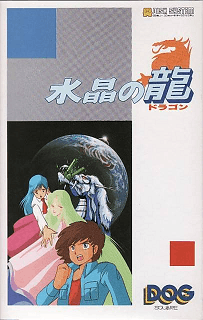Suishō no Dragon
| Suishō no Dragon | |
|---|---|
 | |
| Developer(s) | Square |
| Publisher(s) | Square |
| Composer(s) | Nobuo Uematsu |
| Platform(s) | Family Computer Disk System |
| Release |
|
| Genre(s) | Adventure |
| Mode(s) | Single-player |
Suishō no Dragon (水晶の龍 suishō no doragon, lit. "The Quartz Dragon" or "Crystal Dragon") is an adventure game for the Family Computer Disk System released by Square Co. (current Square Enix) in 1986.
Gameplay
Square Co. released the game under the name DOG (Disk Original Group), and the game plays as a command-style adventure game. The game is set in a science fiction-like setting, where the teenage main character must investigate a series of kidnappings and the mysterious dragon that suddenly appeared in outer space.
Many of the game's scenes involve animation, which was a specialty of Square Co. at the time, and Suishō no Dragon features a variety of anime drawings, particularly those of girls. Anime artist Gen Sato served as the character designer and illustrator on the staff, and Nippon Sunrise (current Sunrise Inc.) contributed to the animated parts of the game.[1]
The game's interface was also innovative, resembling that of a point-and-click graphic adventure interface for a console. The game made use of visual icons rather than text-based ones to represent various actions, and it featured a cursor that could be moved around the screen using the D-pad to click on the icons and examine parts of the scenery.[1][2]
Fake scene
The most iconic scene in the game is the frame where one of the heroines, Cynthia, is depicted standing with her arms spread outwards. This drawing inspired a famous fake game scene created by Family Computer Magazine (Famimaga); a prominent video game magazine published by Tokuma Shoten. The magazine explained that it was possible to start a game of yakyuken (野球拳, strip rock-paper-scissors) using a cheat, though this is not actually possible in the game. An altered screenshot showing the heroine losing her clothes was included alongside the article. This was not done to fool readers, but to test whether the magazine's content was being copied by other game magazines. This fake scene developed popularity on its own, and many users were made aware of this scene even if they had never played the game before.[2] This phenomenon is described in Kouta Hirano's gag manga, Susume!! Seigaku Dennou Kenkyūbu (進め!!聖学電脳研究部), which was serialized in the Famitsu game magazine. A flash movie simulating this fake scene has been released on the internet.
Other Media
Suishō no Dragon, is one of the video games was adapted by Manga titled Susume!! Seigaku Dennou Kenkyuubu (進め!!静学電脳研究部 Shiawase no katachi), published in the Gamest Comics collection from April 1999, drawned by Kouta Hirano.
References
- 1 2 "水晶の龍 - SQUARE ENIX". Square Enix Japan. Retrieved 2008-05-26.
- 1 2 "やーきゅーうー、すーるなら!? 「水晶の龍(ドラゴン)」". ITMedia. 2006-08-22. Retrieved 2008-05-26.